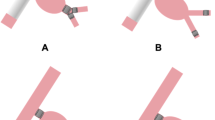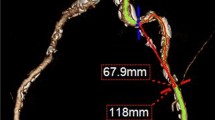Purpose: To investigate initial and long-term success rate after percutaneous treatment of iliac artery occlusion with angioplasty and stent deployment. To investigate the influence of vascular comorbidity, lesion length, stent placement and lesion coverage as possible predictors of outcome. Methods: Between January 1994 and December 1999, 80 iliac recanalizations were performed on 78 patients, median age 61.1 ± 11.5 (SD) years. All patients were followed up by clinical examinations, duplex ultrasound and intravenous digital subtraction angiography. Mean follow-up time was 2.0 ± 1.53 (SD) years. Multivariate Cox regression analysis was used to determine the influence of cofactors on patency. Results: One, 2 and 4 years after recanalization, primary patency was 78.1%, 74.5% and 64.0%; secondary patency was 88.8%, 88.8% and 77.9%, respectively. Patients with shorter occlusions, complete lesion coverage and patent ipsilateral femoral arteries had significantly longer patency rates. Complications included inguinal hematoma (n=1), technical failure (n=3) aortic dissection (n=1), embolic occlusions (n=7), gluteal claudication (n=1) and genital necrosis after subsequent urethral surgery in one patient with contralateral occlusion and ipsilateral overstenting of the internal iliac artery with subsequent stenosis. Complications were of permanent clinical significance in seven of 78 (9%) of the patients. In 17 (22%) cases, percutaneous reintervention was performed with angioplasty in the stent (n=16) or deployment of a new stent (n=1). Conclusion: Endoluminal stent placement has its place in an interdisciplinary therapeutic approach as a viable therapeutic alternative to major transabdominal bypass surgery and can be performed with comparable complication rates. Patients with short occlusions, patent femoral arteries, and stents covering the entire occlusion have significant longer patency.
Similar content being viewed by others
Author information
Authors and Affiliations
Rights and permissions
About this article
Cite this article
Funovics, M., Lackner, B., Cejna, M. et al. Predictors of Long-Term Results After Treatment of Iliac Artery Obliteration by Transluminal Angioplasty and Stent Deployment. CVIR 25, 397–402 (2002). https://doi.org/10.1007/s00270-002-1877-1
Issue Date:
DOI: https://doi.org/10.1007/s00270-002-1877-1




